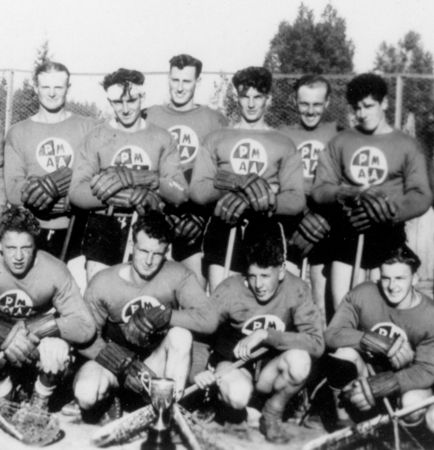
 604 465 4322
604 465 4322General Store Site 12294 Harris Road Pitt Meadows, B.C.
Click Here for Directions& Visiting Hours

Looking Back: 1939 to 1949
Looking back article from August 2017
* The image features a cropped image of the PM Lacrosse Team from 1939/40 which was part of the Pitt Meadows Athletic Association.
It is early 1939 and Canada is in the last months of the depression years. While the economy is being rebuilt, we are also celebrating the visit of the Royal Family to Canada that started on May 17th when George VI, who had been on the throne for just less than 12 months, and his wife Elizabeth visited all the provinces and Newfoundland. They arrived in BC at the end of May and likely passed through Pitt Meadows on the train that took them westward into Vancouver. The monarch returned home on June 15th, just 12 weeks before Britain declared war on Germany on September 3rd. Canada, as a member of the Commonwealth, entered a week later, on September 10th. From Pitt Meadows, more than 69 individuals would enlist and go to war.
At home, the Pitt Meadows Athletic Association had formed early in 1938, and in 1939 established an intermediate lacrosse team and built a box out behind the Hall. This group of young men would go on to win the 1940 Provincial Intermediate Championship. 1940 could have been disastrous for the one industry in Pitt Meadows, Alouette Peat on McTavish Road, when fire consumed the site. The plant was rebuilt and operated full tilt from 1942 to almost war end harvesting peat to send to Las Vegas to be used in bombs. By the end of the war the peat was pretty much harvested off and blueberries were going in and the land would eventually become Blueboy Blueberries.
One single event of WWII that impacted Pitt Meadows to this day was the bombing of Pearl Harbor on December 7th, 1941. With that attack, Pitt Meadows formed their ARP and set up their first fire department that was run out of Hans Hoffmann’s shop. This community’s little red fire truck (that still appears in the Pitt Meadows Day parade) was built by Hans and the other volunteers who made up that department. The darker side of the bombing was the eventual internment of Japanese Canadians to the interior of the province and to Manitoba. By late 1942 this vital population was gone from Pitt Meadows and soon their community hall would be sold. While none of these families returned to live in this community, their hall still stands on Advent Road and has recently been included on a list of Japanese Canadian historic places in BC.
It was also during the War years the first warehouse building was put on the site of what is now Otter Co-Op; the basement of the original school house became a manual training shop and home economics classes began; a Pitt Meadows chapter of the P.T.A. was started; a new post office was opened on the site that now houses the Hollywood 3 theatre; and Maxwell Cameron’s report on school districts in the province brought about the merger (in 1945) of Pitt Meadows and Maple Ridge as school district 42.
With the War over Pitt Meadows continued to build its community spirit. The Gun Club established in 1946 and in 1947 the first Boy Scouts and Girl Guides groups were organized. That same year the outdoor pool in Harris Road Park opened and Harold Sutton began 18 years as Reeve of Pitt Meadows. During the early years of his term Pitt Meadows became part of the Greater Vancouver Water District and would have water mains by 1948. That same year water was everywhere in late May and early June when all our rivers were flooding along the then 26 miles (40 kilometers) of dykes into the lowland areas of the municipality and north into what would become Pitt Polder.
As the 1940’s came to a close, on the east coast Newfoundland joined confederation (April 1, 1949) and on the west coast the Queen Charlotte earthquake happened on August 22nd. In our community, Pitt Meadows topped 1,400 residents and had its first rural route post boxes. Finally, that same year (1949) a Dutch man, Jan Blom, had his first look at the flooded land he would soon purchase and name Pitt Polder.
In August, we will look at the next few decades starting in 1950.
Leslie Norman, Curator at the Pitt Meadows Museum and Archives





